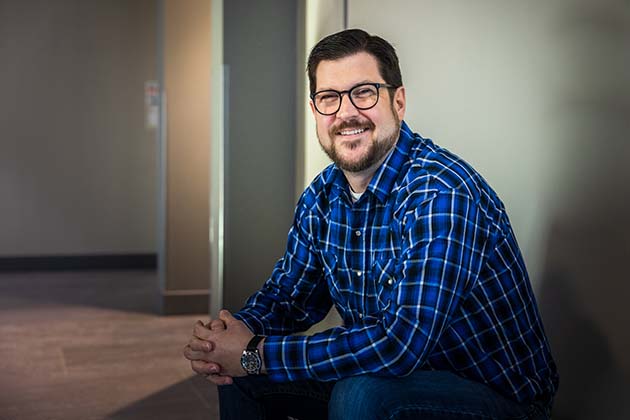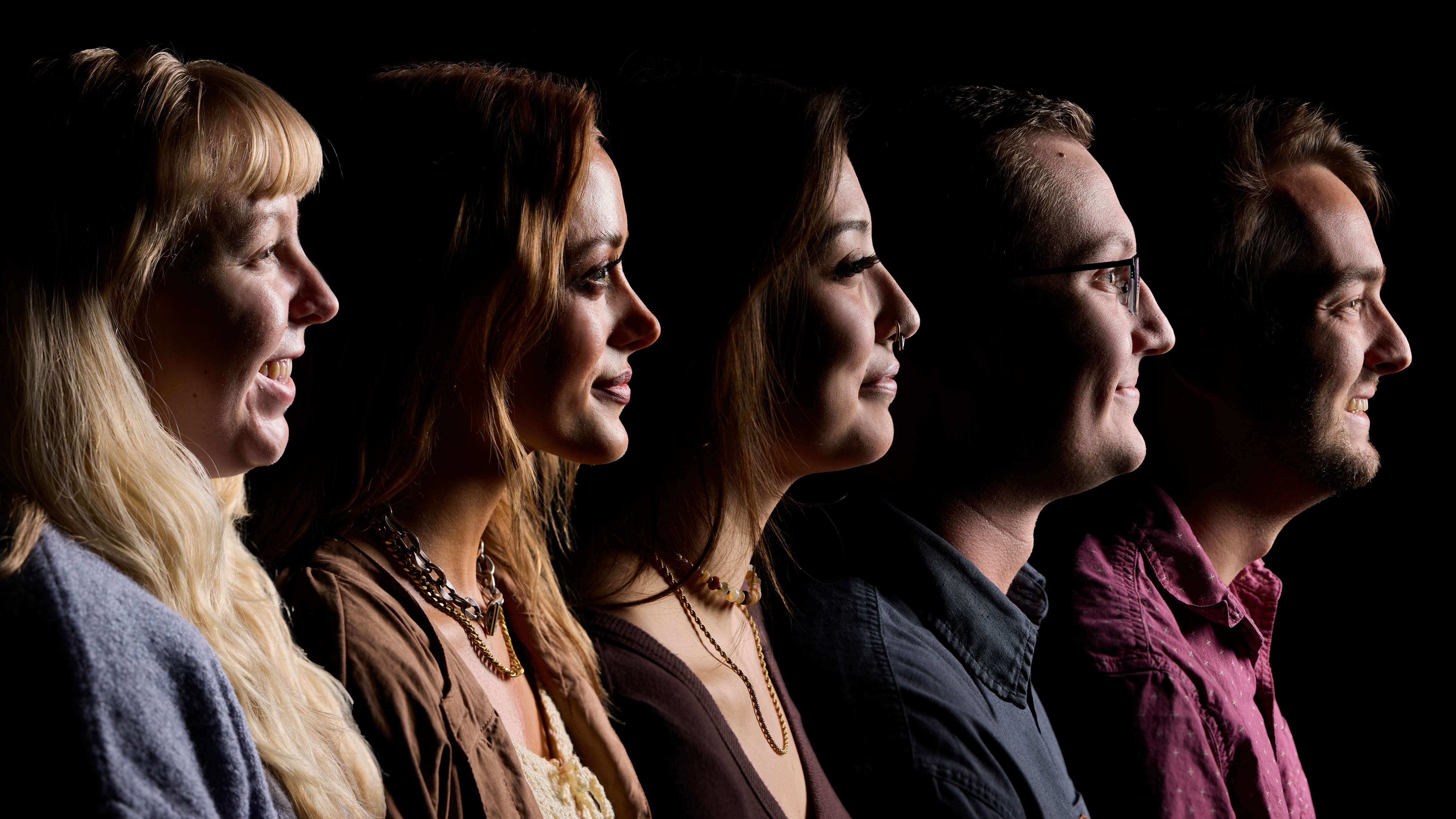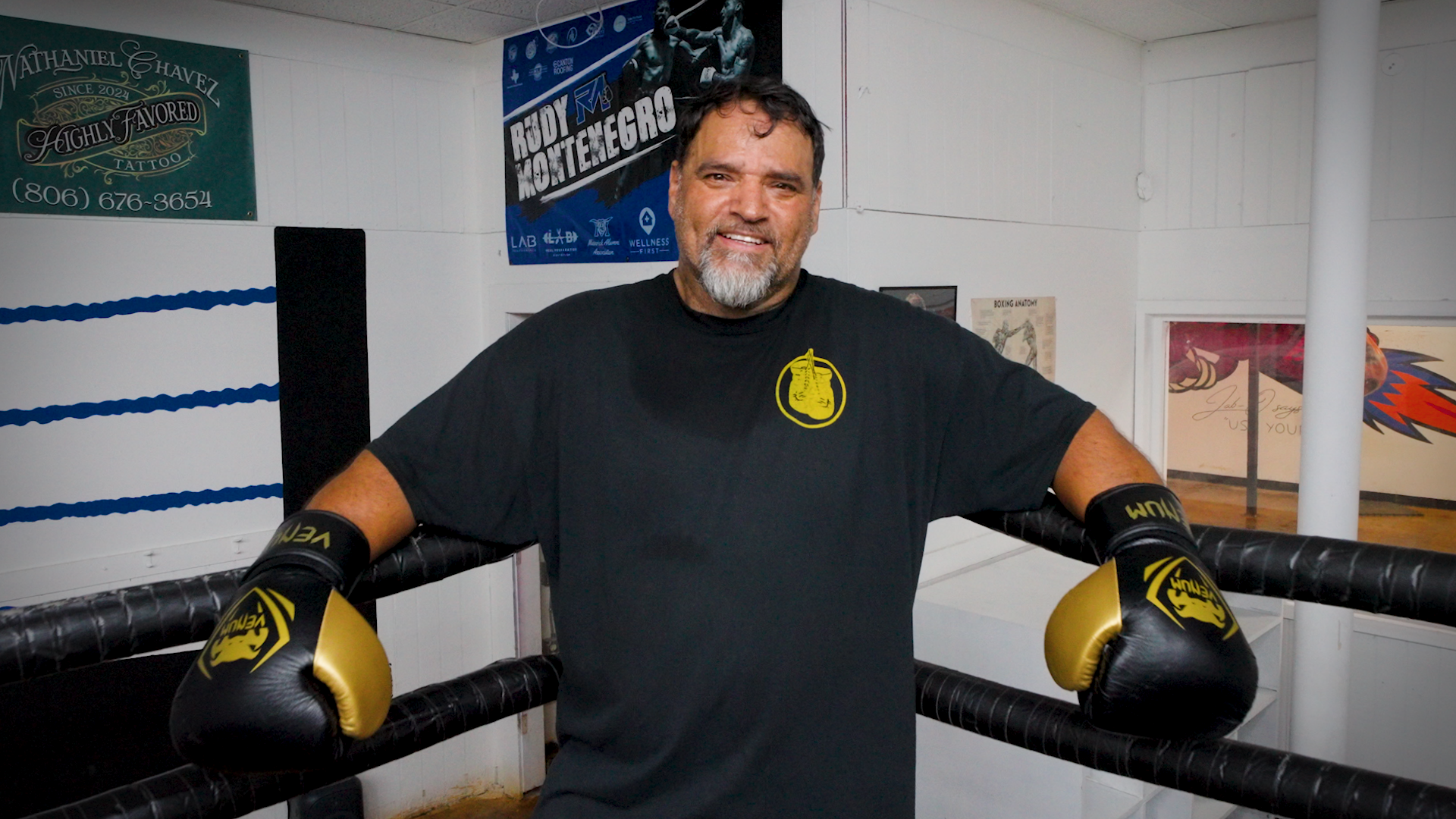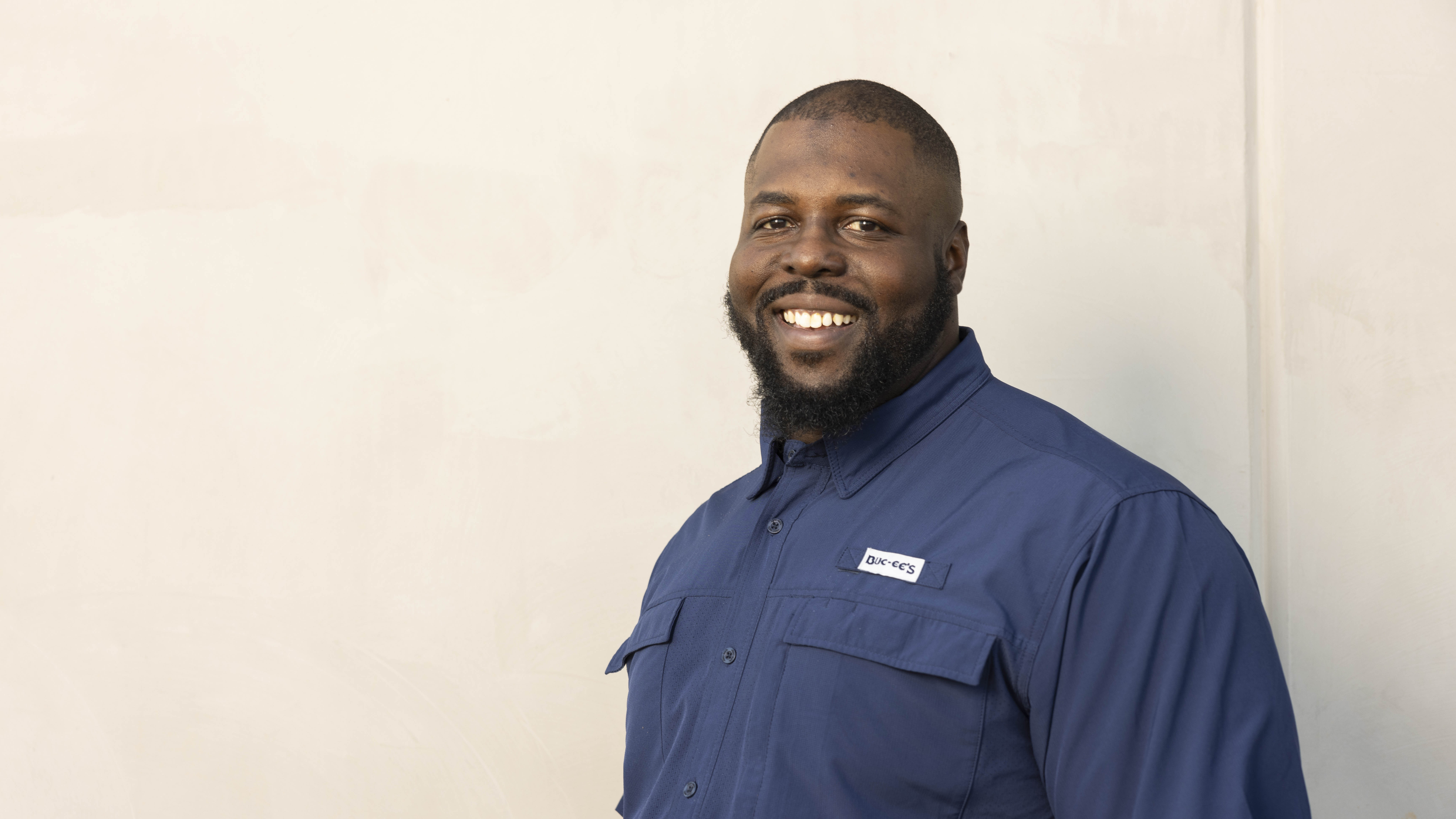Pantex Blog
Pantex Proud: John Laseter

Thousands of dedicated Pantexans like John Laseter work every day to support the Pantex mission. Take three minutes to learn about who he is, what he does, and why he is proud to be a Pantexan.
“A job worth doing is a job worth doing right.” The words of John Laseter’s late father echo in his life every day as a Pantexan.
“Working at Pantex reinforces that purpose,” Laseter said. “This mission is extremely important to the nation, and I’m proud to be a part of that. Technically and geopolitically, what we do is fascinating and also intimidating; but regardless of whatever team you’re on, you have to have pride in the job.”
Laseter came from the banking world, bringing his information technology (IT) background to Pantex, where he serves as a software engineer. He’s part of a dedicated team that manages and maintains various applications such as Process Workflow Management, iTools, and eDC/RO. He is happy and proud to be part of a group with a singular purpose.
“I love the team that I’m with,” Laseter said. “Everybody in IT is super cool, respectful, and dedicated to their jobs and the mission. We all have different talents and proficiencies, and having a team with varying approaches is critical for best possible output.”
Recently, Laseter learned that truth in the best way possible – through experience. Working alongside fellow IT staff as well as individuals from other organizations, he played a key role in the completion of a major undertaking that he is extremely proud of.
“The Pantex Visitor Access Project,” he said. “It was an overhaul of the Pantex access and escort request process. There were lots of growing pains but it’s proven a positive change. I’m really glad Pantex did this and that I was a part of the team that implemented it.”
In his time on the project, Laseter took away many important lessons and it reinforced some of his preexisting values about an individual’s contribution and responsibility to group work.
“What we do at Pantex is a total team effort,” he said. “Being honest and taking responsibility for your actions builds trust and openness among teammates. You can’t expect others to hold you accountable. You’re that last line of defense. Owning up is something only you can do.”
What advice would you give to a new employee?
Don’t try to be an expert in everything at once. It’s going to take a while. You may have preconceived notions about Pantex and your job, but actually doing the job is more important when it comes to fully understanding Pantex and gaining skills.
What’s your top bucket list item and why?
I’ve grown into liking classical music, especially live performances. I saw Beethoven’s Symphony No. 9 and it was an emotional experience. I really want to hear Bruckner’s Symphony No. 7 live.
Who has inspired you the most?
My dad. I got everything from him. Name, looks, 90% of my personality, work ethic, and outlook on life. I picked up his values and ethics and more without thinking about it, kind of like through osmosis. He refused to do anything that was questionable. And he always stuck to his guns.
Pantex Proud: Jeramy Jones
Thousands of dedicated Pantex citizens like Jeramy Jones work every day to support the Pantex mission. Take three minutes to learn about who he is, what he does, and why he is proud to be a Pantexan.
Usually babysitting a younger sibling results in a “thank you” or if you’re lucky a few dollars and some take-out pizza. But for Jeramy Jones, watching his younger stepsister as a teen led to him being an at-home winner on The Bozo Show’s Grand Prize Game.
“At the time, I was babysitting and Bozo’s was one of the shows my sister would watch and it kept her entertained,” Jones said. “There was an advertisement for an at-home player, so I entered the drawing just to have her enter too. The at-home player won a duplicate of every prize won by the live in-studio player. I didn’t even know I was selected, but the next thing I know there are boxes of prizes showing up at our door.”
Jones won several prizes and toys, but his favorite was a year’s supply of Big League Chew bubblegum. Several years later, the bubble never popped, and Jones continued his winning streak by being hired on at Pantex in 2001. As the Waste Compliance section manager, he serves Pantex by leading the team that ensures compliance with federal and state regulations. While the Big League Chew may have lost its flavor long ago, Jones never lost his passion for the job.
“I have worked at Pantex for over 24 years. My team and I contribute to the mission success by reviewing, characterizing, and documenting all waste-generating processes so that Pantex remains compliant with all regulations,” Jones said. “It brings me joy to think that I work at a place that truly makes a difference in the world. I am proud to be a Pantexan, because I know that the work we all do contributes to nuclear deterrence.”
What do you think makes Pantex so special?
There is no other place that can do what we do the way we do it!
Why is being open to learn from others critical for mission success?
Being able to learn from others is so important at Pantex because we are so specialized. Knowledge and work practices being shared and passed down from current and past employees are many times vital to complete job tasks.
What does operational excellence mean to you?
To me, operational excellence can be simply stated as, ‘everything that you do, do it with excellence.’
Why is teamwork important?
Teamwork is very important in our group. The adage, ‘no man is an island’ rings true with us and is necessary to aid in the continuous learning process. Everyone brings something special to the table.
What advice would you give to a new employee?
Be patient and don’t be too quick with trying to change the world. Be a sponge and soak up as much as you can about the processes out here so that when your time comes, you’re ready to add something special.
Why is giving back to the community important?
Our communities are special to all of us. It is where we call home. Giving back helps those that aren’t as fortunate within our community. I consider it a pleasure.
What’s your favorite outside-of-work activity and why?
My activities outside of work involve chasing my grandson around. When I’m not doing that, I am either spending time with my family or on the golf course.
Uncleared Connections: Fab Five

Kierya Freiboth, Macey Ray, Alicia Bermudez, Hunter Rose, and Riley Blacksten
The crowd is on its feet, a deafening roar filling the arena. Michigan has possession, and the ball is in the hands of Jalen Rose who is calmly dribbling past half-court before passing to an open Chris Webber. Time is ticking away – five seconds, four seconds, three ... The clock hits zero and ... SWISH! The Fab Five has done it again.
The 1991 Michigan Wolverines Fab Five basketball team is considered one of the greatest recruiting classes of all time. While Pantex doesn’t compete in college basketball, we also recruit and retain the best of the best to achieve our national security mission. That includes our own group of five fabulous weapons engineers: Macey Ray, Hunter Rose, Kierya Freiboth, Alicia Bermudez, and Riley Blacksten.
“We work for the Weapons Material Program,” Freiboth said. “As material engineers, our group owns the entire life cycle of materials used across the plant. We are involved with various working groups and programs to ensure needs are met throughout the site.”
The five Pantexans started right out of college then spent the next three months in the uncleared room where they all sat in the same row, awaiting their clearances. Just like the legendary Michigan team, who was the first in NCAA history to compete in the championship game with all freshman starters, the engineers were the new kids on the block. But just because you’re new doesn’t mean you can’t accomplish great things.
“Pantex is so much different than any other place of employment, so we had a collective lack of knowledge and were going through it together,” Bermudez said. “When we first started, we were assigned big group projects to work, so we were collaborating and learning as a team.”
“We were able to learn as a group,” Ray said. “We are very team oriented, collaborating on the same work day in and day out. At first, it was doing uncleared work together but then we became friends out of it and started doing things outside of work.”
Rose, Freiboth, and Bermudez aren’t local to Amarillo. Ray and Blacksten helped welcome them to the area by socializing after work and attending local events they all enjoyed.
“It can get lonely without friends and knowing the area,” Bermudez said. “I think networking in the uncleared room helps with retention. Before I moved here, I didn’t know how long I would stay, but I like it here now. You’re here for 9 hours a day; if you’re not friends with people you work with, it makes it harder to find friends outside of work.”
“Meeting each other in the uncleared room diversified our knowledge outside of what we’re the subject matter expert over, so we’re more well-rounded,” Freiboth said.
From concerts to hiking to game nights, the group is together more often than they’re apart. They do so much outside of work that it makes it so there are no communication barriers at the plant.
“It’s so nice that it translates from outside of work. We hold each other accountable,” Ray said. “Since I see us all on the same playing field, it’s motivating because I don’t want to be the one dragging us down, so it makes us work harder for each other.”
Thanks to their own positive experience in the uncleared room, the group had advice for new Pantexans going in.
“In your downtime between trainings, don’t just focus on the screen – focus on the people,” Bermudez said. “There is work to do and it’s important to do it, but the connections you make in there will be what help you get work done as you progress in your career. You grow your social skills by networking with the people around you. Use that as an opportunity. There is no better time to start.”
So, while the material engineers won’t be shooting hoops at a collegiate level anytime soon, their friendship does score major points.
“Pantex would’ve been great without them, but it is 10 times better with them,” Ray said.
People of Pantex: Andy Sotelo

For Pantex expediter Andy Sotelo, boxing saved his life. He knew while growing up in the small town of Fairview, Montana, that there were more ways to find trouble than not, but boxing gave him purpose and drive.
“Coach said ‘come and practice,’ so we did, and it kept us off the streets,” Sotelo said. “Also, my uncles used to box so I kind of wanted to follow their footsteps.”
Sotelo boxed competitively for 13 years starting in middle school before moving on to amateur level fighting as a 165-pound middleweight. Over his career he boxed in 130 matches, winning 100 of them.
Sotelo’s lucky number must be five as he is a five-time Golden Gloves champion, five-time state champion, and five-time regional champion. He went to nationals five times, placing as high as third in the nation.
“I've been knocked down a couple of times, but never knocked out,” he said. “And I still got my teeth.”
For Sotelo, boxing wasn’t just a fun sport he was good at; he loved the opportunities it gave him to travel and see more of the country. He once fought at the Olympic Center in Colorado Springs, Colorado, and in Canada four different times. He fought among those who would later make big names for themselves such as Floyd Mayweather Jr., Antonio Tarver, Jermain Taylor, and Jeff Lacey.
One of the biggest matches Sotelo fought was against Canada’s national champion in 1998 and was broadcast on national TV. A fight that he won.
“I sometimes regret not going pro,” he said. “But I know I’m where I’m supposed to be.”
As an expediter, Sotelo has handled material moves with a forklift for seven years after starting his Pantex career as a custodian. Before that, he ran his own cleaning business for the 13 years.
“It's very important we bring material down to the south end, or to the north end,” he said. “It's a pretty good job to have and working on your skills is huge.”
Like boxing, Sotelo says his job requires practice, focus, and having the right mindset to be prepared for anything, because every fight is different.
“In boxing, working on your skills is everything and that translates to my job,” he said.
Sotelo continues to be involved in boxing as exercise. He’s still got the speed and heart, but gets tired more quickly than he used to. He also continues his involvement as a mentor to younger hopefuls. He feels honored to show them the basics.
Both his son and daughter got into boxing for a while and his daughter was especially impressive. He’d like to get even more involved in working with young boxers to share some of the life advice that has helped him in his life.
“From inside the ring to outside of the ring, be confident, be positive,” Sotelo said. “Sometimes life is a struggle, you know, it’s just how you roll with the punches. Just make the best of it.”
Watch this video to watch Andy Sotelo, amateur boxer and proud Pantexan, in action.
Pantex Proud: Michael Sauls

Thousands of dedicated Pantex citizens like Michael Sauls work every day to support the Pantex mission. Take three minutes to learn about who he is, what he does, and why he is proud to be a Pantexan.
Continuous learning is on the forefront of our minds today, with countless people learning for the sake of it. Maintenance Planner Michael Sauls is learning for the generations to come.
Sauls, who has been a Pantexan for the last seven years, started as a material handler and worked his way to being an area mechanic four years later. After two more years working on vehicles, he moved into his current role. With planner in his title, it is no surprise that Sauls is working towards making the plant better, not only for today, but for future generations of Pantexans.
“I try to be a futuristic person,” Sauls said. “I want to build a better future for our new people coming up. It’s hard to be heard sometimes, so I use my ability to speak up for others when they can’t.”
Making sure things work well together is Sauls’ specialty; whether that be the people he works with or the way he plans maintenance work, everything Sauls does is for a reason.
“We get everything for the job put together for colleagues to be able to perform work smoothly so they don’t have to worry about being able to do their job,” Sauls said. “Because we have different experiences, I know we will handle situations differently, but I am able to work with everyone — and learn from them — because at the end of the day I know we are working towards the same goal.”
Sauls is also learning a new language, one that he thinks will serve him well when he considers future work: coding. After some health issues during adolescence, Sauls found that he loved technology and has tried keeping up with the ways it could affect him. Considering technological advancements the plant is implementing, Sauls is excited about the way things are moving forward.
“I see the direction we are going as a plant and I don’t want to limit myself,” Sauls said.
Through constant learning and with the support of his ever-growing community, Sauls continues to push his limits and develop as a proud Pantexan.
What do you enjoy most about working at Pantex?
The people are what make this place very enjoyable. Learning what makes us different is really intriguing to me.
What do you think makes Pantex so special?
The accountability we have within the people. Pantex trusts us every day to make the right decisions, inside and outside of this place. It speaks volumes when you build a community based on trust in a diverse company like this.
Anything else you’d like to add about your role, your team, and/or Pantex/the mission?
Anything and everything that I can bring to my role or team is growth. I always want to exceed expectations for the company and with people every day. When you’re able to develop and grow with people, you continue to learn more about them and yourself.
What’s your top bucket list item and why?
I want to travel the world, but I don’t have specific places in mind. I want to be able to enjoy the wonders of the world and to actually see those wallpapers we get on our computer. Someone had to capture it in life; I want to be able to capture it in person.
